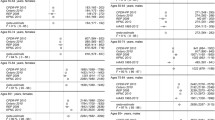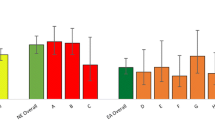Abstract
The prevalence of Parkinson’s disease (PD) in sub-Saharan Africa is still a matter of debate. The few studies that have been conducted have shown prevalences lower than those in the western world. Whether this represents a genuine finding is unclear to date. In northern Tanzania, we have conducted a hospital-based evaluation and a community-based door-to-door study to assess the prevalence of Parkinsonism, including that of PD. Over a period of 8 months, all patients admitted to a mid-size rural hospital were screened for PD. In parallel, 1,569 people aged ≥50 years were recruited from the communities and assessed for PD with standard questions. Sampling was performed according to the method of “multistage cluster sampling.” The questions had previously been tested in a pilot study prior to the survey. People who screened positive were examined by a specialist neurologist. In the hospital, eight of 740 people with neurological diagnoses had Parkinsonism, of whom three patients had a diagnosis of PD. In the community-based study, 18 people answered positively to least one of the 12 screening questions. However, the diagnosis of PD could not be confirmed by further examination in any of them. The prevalence of PD in northern Tanzania was found to be very low. This result would need confirmation in studies with larger populations, ideally of different African ethnicities.

Similar content being viewed by others
References
Balogou AA, Doh A, Grunitzky KE (2001) Neurological disorders and endemic goiter: comparative analysis of 2 provinces in Togo (article in French). Bull Soc Pathol Exot 94:406–410
Bower JH, Teshome M, Melaku Z, Zenebe G (2005) Frequency of movement disorders in an Ethiopian university practice. Mov Disord 20:1209–1213
Chaudhuri KR, Hu MT, Brooks DJ (2000) Atypical parkinsonism in Afro-Caribbean and Indian origin immigrants to the UK. Mov Disord 15:18–23
Cosnett JE, Bill PL (1988) Parkinson’s disease in blacks. Observations on epidemiology in Natal. S Afr Med J 73:281–283
Dorsey ER, Constantinescu R, Thompson JP, Biglan KM, Holloway RG, Kieburtz K et al (2007) Projected number of people with Parkinson disease in the most populous nations, 2005 through 2030. Neurology 68:384–386
Dotchin C, Msuya O, Kissima J, Massawe J, Mhina A, Moshy A et al (2008) The prevalence of Parkinson’s disease in rural Tanzania. Mov Disord 23:1567–1672
Duarte J, Clavería LE, de Pedro-Cuesta J, Sempere AP, Coria F, Calne DB (1995) Screening Parkinson’s disease: a validated questionnaire of high specificity and sensitivity. Mov Disord 10:643–649
Gibb WRG, Lees AJ (1989) The significance of the Lewy body in the diagnosis of idiopathic Parkinson’s disease. Neuropathol Appl Neurobiol 15:27–44
Haimanot RT (1985) Parkinson’s disease in Ethiopia: a prospective study of 70 patients. East Afr Med J 62:571–579
Haydom Annual Report 2004. Haydom Lutheran Hospital, Mbulu, Tanzania
Hu MT, Chaudhuri KR, Jarosz J, Yaguez L, Brooks DJ (2002) An imaging study of Parkinsonism among African-Caribbean and Indian London communities. Mov Disord 17:1321–1328
Lombard A, Gelfand M (1978) Parkinson’s disease in the African. Cent Afr J Med 24:5–8
Matuja WB, Aris EA (2008) Motor and non-motor features of Parkinson’s disease. East Afr Med J 85:3–9
Mayeux R, Marder K, Cote LJ, Denaro J, Hemenegildo N, Mejia H et al (1995) The frequency of idiopathic Parkinson’s disease by age, ethnic group, and sex in northern Manhattan, 1988–1993. Am J Epidemiol 142:820–827
McInerney-Leo A, Gwinn-Hardy K, Nussbaum RL (2004) Prevalence of Parkinson’s disease in populations of African ancestry: a review. J Natl Med Assoc 96:974–979
Okubadejo NU, Danesi MA (2004) Frequency and predictors of autonomic dysfunction in Parkinson’s disease: a study of African patients in Lagos, Nigeria. Niger Postgrad Med J 11:45–49
Okubadejo NU, Bower JH, Rocca WA, Maraganore DM (2006) Parkinson’s disease in Africa: a systematic review of epidemiologic and genetic studies. Mov Disord 21:2150–2156
Okubadejo NU (2008) An analysis of genetic studies of Parkinson’s disease in Africa. Parkinsonism Relat Disord 14:177–182
Olsen BE (2002) Motherhood—a hazardous endeavour. Maternal deaths and urinary tract infections in pregnancy in rural northern Tanzania. PhD thesis, Centre for International Health, Bergen, Norway
Osuntokun BO (1971) The pattern of neurological illness in tropical Africa. Experience at Ibadan, Nigeria. J Neurol Sci 12:417–442
Osuntokun BO, Bademosi O (1979) Parkinsonism in the Nigerian African: a prospective study of 217 patients. East Afr Med J 56:597–607
Osuntokun BO, Adeuja AO, Schoenberg BS, Bademosi O, Nottidge VA, Olumide AO et al (1987) Neurological disorders in Nigerian Africans: a community-based study. Acta Neurol Scand 75:13–21
Pramstaller PP, Falk M, Schoenhuber R, Poewe W (1999) Validation of a mail questionnaire for Parkinsonism in two languages (German and Italian). J Neurol 246:79–86
Population and Housing Census 2002. Manyara, Mbulu. http://www.tanzania.go.tz/census/census/districts/mbulu.htm. Last accessed 29 October 2009
Richards M, Chaudhuri KR (1996) Parkinson’s disease in populations of African origin: a review. Neuroepidemiology 15:214–221
Schoenberg BS (1982) Clinical neuroepidemiology in developing countries: neurology with few neurologists. Neuroepidemiology 1:137–142
Schoenberg BS, Anderson DW, Haerer AF (1985) Prevalence of Parkinson’s disease in the biracial population of Copiah County, Mississippi. Neurology 35:841–845
Tekle-Haimanot R, Abebe M, Gebre-Mariam A, Forsgren L, Heijbel J, Holmgren G et al (1990) Community-based study of neurological disorders in rural central Ethiopia. Neuroepidemiology 9:263–277
von Campenhausen S, Bornschein B, Wick R, Bötzel K, Sampaio C, Poewe W et al (2005) Prevalence and incidence of Parkinson’s disease in Europe. Eur Neuropsychopharmacol 15:473–490
Zhang ZX, Román GC (1993) Worldwide occurrence of Parkinson’s disease: an updated review. Neuroepidemiology 12:195–208
Acknowledgments
Our special thanks go to the local population and all of our local helpers, without whom this study would not have been possible. ASW was supported by the Centre for International Migration (CIM), Frankfurt, Germany.
Conflict of interest statement
The authors declare no conflict of interest.
Author information
Authors and Affiliations
Corresponding author
Electronic supplementary material
Below is the link to the electronic supplementary material.
Appendix
Appendix
Screening questions asked in consecutive order [7, 23].
-
1.
Do you have trouble arising from a chair?
-
2.
Has anybody told you that your voice is softer than it once was?
-
3.
Is or was your balance poor?
-
4.
Do your feet even seem to get stuck to the floor?
-
5.
Has anyone told you that your face seems less expressive than it once was?
-
6.
Do your arms or legs shake?
-
7.
Are your arms or legs stiff?
-
8.
Do you have trouble fastening buttons?
-
9.
Do you shuffle or take small steps when you walk?
-
10.
Do you have difficulties to start or stop walking?
-
11.
Is your handwriting smaller than it once was?
-
12.
Has anybody ever told you that you have Parkinson’s disease?
Rights and permissions
About this article
Cite this article
Winkler, A.S., Tütüncü, E., Trendafilova, A. et al. Parkinsonism in a population of northern Tanzania: a community-based door-to-door study in combination with a prospective hospital-based evaluation. J Neurol 257, 799–805 (2010). https://doi.org/10.1007/s00415-009-5420-z
Received:
Revised:
Accepted:
Published:
Issue Date:
DOI: https://doi.org/10.1007/s00415-009-5420-z




